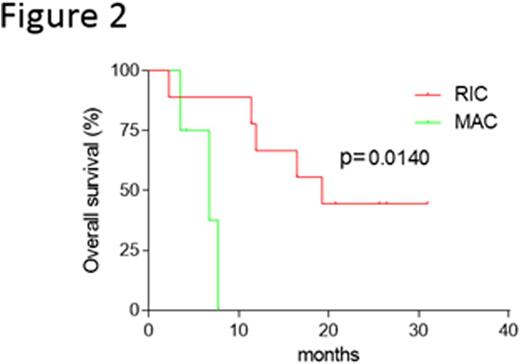Abstract
Introduction: Despite recent improvements in the treatment of adult acute myeloid leukemia (AML), many patients still fail to achieve complete remission (CR) or relapse early after response to initial induction chemotherapy. Outcome of patients with primary refractory/relapsed (R/R) acute myeloid leukemia (AML) remains dismal. Nevertheless, most of these patients undergo salvage chemotherapy. Gemtuzumab ozogamicin (GO) is an antibody-targeted chemotherapy agent consisting of a humanized murine anti-CD33 monoclonal antibody linked to calicheamicinϒ1, a potent antitumor antibiotic. Binding of GO induces cell death in CD33-positive cells by internalization of the calicheamicin drug and toxin release intracellulary leading then to then cleavage of double-stranded DNA. In relapsed AML, GO used alone with an unfractionated dose of 9 mg/m² on days 1 and 14 resulted in 13% of CR and a median OS of 5 months. Combined with intermediate-dose cytarabine and mitoxantrone, unfractionated dose of GO gave 50% of CR in patients with R/R AML, and a 2-year OS of 41%. However, early toxic deaths were reported related to sinusoidal obstruction syndrome (SOS). These results were confirmed by subsequent studies evaluating unfractionated GO combined with various agents in patients with R/R AML. The main objective of the present retrospective study was to evaluate the efficacy of the combination of fractionated GO with intermediate-dose cytarabine and daunorubicin in very high-risk patients with AML, and its potential use as bridge to transplant in this patient population.
Methods: Herein we present a retrospective monocentric study of 24 very high-risk AML patients who received a combination of fractionated gemtuzumab ozogamicin (GO) with intermediate-dose cytarabine and daunorubicin as salvage therapy.
Results: Median age was 55.3 years. Diagnoses were secondary AML for 33% of them. Seven patients had favorable, 8 had intermediate-1 or intermediate-2 and 6 unfavorable-risk AML according to the European LeukemiaNet prognostic index. Complete remission rate was achievied in 50% of cases (46% in refractory and 55% in relapsed AML) without excessive toxicity. Only allogeneic hematopoietic stem cell transplantation provided a benefit in this patient cohort with a one-year overall survival of 50.7% versus 18.1% in the absence of transplantation. Patients treated with reduced intensity conditioning (RIC) showed a higher survival as compared to those undergoing myeloablative conditioning regimen. CD33 expression was not associated with survival. In multivariate analysis in a model including the age older than 60 years, allo-HSCT, refractory AML and achievement of CR after GO, only the performance of allo-HSCT predicts patients' outcome with a Hazard Ratio (HR) of 0.25 (95% CI 0.07-0.86), p=0.02.
Conclusions: Our data suggest that salvage therapy with fractionated GO combined with intermediate-dose cytarabine and daunorubicin in very high-risk patients may serve as a potential bridge therapy to RIC transplant. Data from studies published after withdraw of GO from the market, of which our present study, suggest that the licence status of GO might be reviewed, at least for certain subtypes of patients and certain situations of which R/R AML patients.
Nicolini:Novartis: Honoraria, Membership on an entity's Board of Directors or advisory committees, Research Funding; BMS: Consultancy, Honoraria; Ariad pharmaceuticals: Honoraria, Membership on an entity's Board of Directors or advisory committees. Salles:Gilead: Honoraria, Research Funding; Roche/Genentech: Consultancy, Honoraria, Research Funding; Mundipharma: Honoraria; Amgen: Consultancy, Honoraria; Novartis: Consultancy, Honoraria; Celgene: Consultancy, Honoraria; Janssen: Consultancy, Honoraria. Thomas:Pfizer: Consultancy.
Author notes
Asterisk with author names denotes non-ASH members.



This feature is available to Subscribers Only
Sign In or Create an Account Close Modal